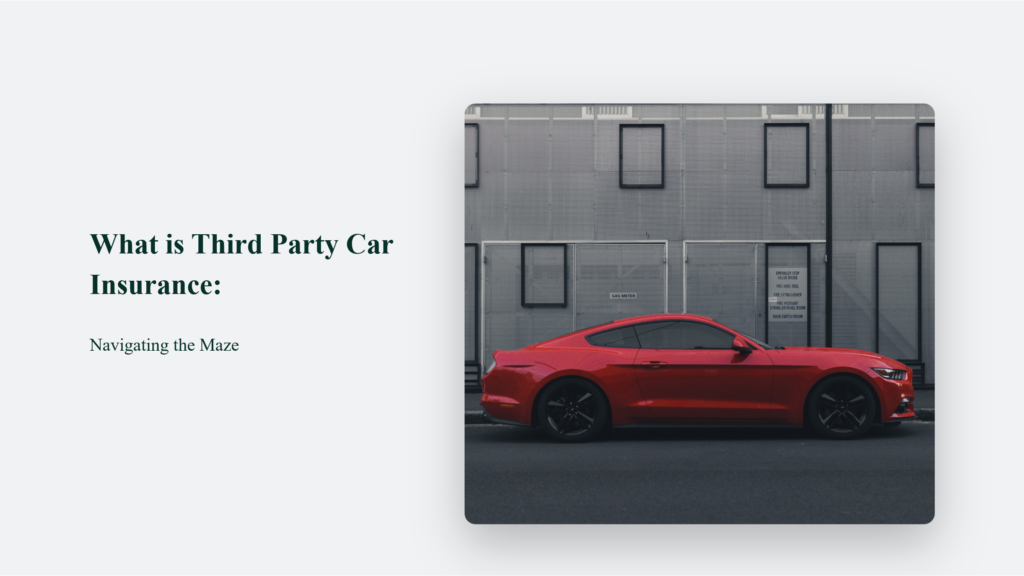

What is Third Party Car Insurance: Navigating the Maze

As Seen On
Ah, third-party car insurance – the unsung hero of the Aussie roads! You’ve probably heard about it, maybe even grumbled a bit when paying for it, but have you ever stopped to think about what is third party car insurance?
It’s like the quiet neighbour who helps you out in a pinch but stays out of your way otherwise. So, let’s dive into the world of third-party car insurance in Australia and unravel its mysteries in plain English.

What is Third Party Car Insurance?
Third-party car insurance, or as I like to call it, the “Oops, Sorry!” cover, is essentially your financial shield if you accidentally play bumper cars with someone else’s vehicle or property. It doesn’t cover your car (that’s a story for comprehensive insurance), but it protects you from burning a hole in your pocket over damages to others.
Types of Third Party Car Insurance:
Navigating through the various types of third-party car insurance in Australia can feel like trying to pick the right avo at the supermarket – you want the best coverage without bruising your wallet. So let’s break down the options available, each with its unique flavour:
Third-Party Property Damage Car Insurance (TPPD):
This one’s like your basic avocado toast – simple yet essential. TPPD covers the damage you might cause to someone else’s vehicle or property. Consider it your financial cushion if you accidentally ding someone else’s ride. It’s typically the most affordable option if you’re looking to cover the essentials without the frills.
Third-Party Fire and Theft Insurance (TPFT):
Here, we’re adding a bit of spice to the mix. TPFT includes everything in TPPD, plus coverage for your car if it’s stolen or damaged by fire. It’s a step up from the basic cover, providing more peace of mind, especially if you’re parking in those not-so-great neighbourhoods or areas prone to bushfires.
Comprehensive Car Insurance:
The full breakfast deal! It includes cover for damages to both your car and others, plus a range of additional perks like coverage for storm and flood damage, theft, and even a hire car in some cases. It’s pricier than the other types, but this is the way to go if you’re looking for top-tier protection. It’s especially worth considering if your car is newer or more expensive.
Compulsory Third Party (CTP) Insurance:
This one’s the non-negotiable. CTP is a mandatory insurance for all registered vehicles in Australia, covering costs linked to injuries and deaths from car accidents. While it doesn’t cover vehicle damage, it’s essential for legal driving. Think of it as the base on which you can build your other insurance choices.
Why Third Party Car Insurance Matters:
Why does third-party car insurance matter in Australia? Let’s put it this way: imagine you’re driving your car and, in an unfortunate twist of fate, you bump into a luxury vehicle. Without third-party car insurance, you’re looking at a potentially massive bill for repairs to the other person’s car. But with third-party car insurance, you’re covered for these costs, saving you from a financial nightmare.
Third-party car insurance is the most basic optional car insurance available to drivers in Australia. It covers you for liability if you damage someone else’s property, be it a car, building, or even a boat. This kind of insurance is a financial lifesaver, ensuring that you won’t be left to foot a possibly enormous repair bill if you’re at fault in an accident.
It typically covers up to $20 million of damage, which is reassuring considering the cost of some vehicles and property. However, it’s crucial to remember that this insurance does not cover damages to your car – that’s where comprehensive car insurance steps in.
The difference between comprehensive and third-party car insurance is significant. While third-party insurance covers damage to other’s property, comprehensive car insurance provides broader protection against theft, fire, or accidental damage, including for your own vehicle.
In terms of cost, comprehensive insurance is more expensive than third-party insurance due to the extensive coverage it offers. For example, insurers like AAMI, Budget Direct, and Bingle offer different rates for both third-party and comprehensive insurance, reflecting the level of coverage each provides.
It’s also worth noting that third-party property damage car insurance differs from Compulsory Third Party (CTP) insurance. CTP is a mandatory insurance required for all registered vehicles in Australia, covering personal injury liability. However, third-party property insurance is optional and provides financial and legal liability cover for damage you may cause to someone else’s property.
The Uninsured Motorist Headache:
What if the other driver doesn’t have insurance, and they’re at fault? Some third-party policies cover this scenario, providing a safety net of up to $5,000. It’s like having an extra ace up your sleeve.
The Extras:
Third-party policies often come with some sweeteners. Things like legal liability coverage, towing, and even cover for your car if it’s stolen or damaged in a fire. And let’s not forget the member benefits and discounts some insurers offer.
Not All Heroes Wear Capes:
Third-party car insurance may not be flashy, but it’s vital to your financial protection team. The unsung hero saves you from the potentially ruinous costs of damaging someone else’s property. Think of it as your financial guardian angel, quietly working in the background.
Frequently Asked Questions:
Does third-party insurance cover damage to my car?
Nope, that’s a job for comprehensive insurance.
What about injuries to people in an accident?
That’s where Compulsory Third Party (CTP) insurance comes in – it’s a mandatory cover attached to your vehicle’s registration in Australia.
Is third-party insurance mandatory in Australia?
Third-party property damage insurance isn’t compulsory, but it’s highly recommended. Compulsory Third Party (CTP) is the only mandatory insurance, which covers injuries to others in an accident where you’re at fault.
The Bottom Line:
In conclusion, third-party car insurance in Australia is like having a safety net, ensuring a driving mishap does not financially ruin you. It’s the wise choice for every Aussie driver who wants to cruise the roads peacefully. So, next time you’re renewing your policy, remember, it’s not just another bill – it’s your financial safeguard on the roads!
Konger
Up until working with Casey, we had only had poor to mediocre experiences outsourcing work to agencies. Casey & the team at CJ&CO are the exception to the rule.
Communication was beyond great, his understanding of our vision was phenomenal, and instead of needing babysitting like the other agencies we worked with, he was not only completely dependable but also gave us sound suggestions on how to get better results, at the risk of us not needing him for the initial job we requested (absolute gem).
This has truly been the first time we worked with someone outside of our business that quickly grasped our vision, and that I could completely forget about and would still deliver above expectations.
I honestly can't wait to work in many more projects together!
Disclaimer
*The information this blog provides is for general informational purposes only and is not intended as financial or professional advice. The information may not reflect current developments and may be changed or updated without notice. Any opinions expressed on this blog are the author’s own and do not necessarily reflect the views of the author’s employer or any other organization. You should not act or rely on any information contained in this blog without first seeking the advice of a professional. No representation or warranty, express or implied, is made as to the accuracy or completeness of the information contained in this blog. The author and affiliated parties assume no liability for any errors or omissions.

